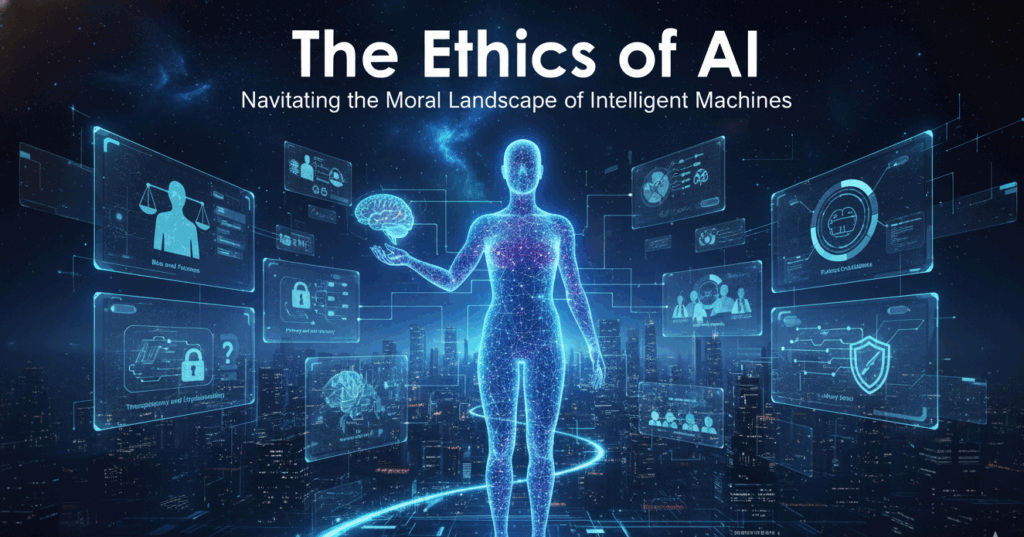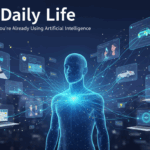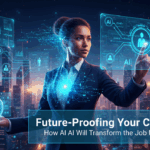Artificial Intelligence (AI) is rapidly transforming our world, bringing unprecedented capabilities and efficiencies across every sector. From revolutionizing healthcare and finance to powering our daily digital interactions, AI promises a future of innovation and progress. However, as AI systems become more autonomous, powerful, and integrated into our lives, a crucial question arises: How do we ensure these intelligent machines operate ethically?
The field of AI ethics is a rapidly evolving discipline that grapples with the moral implications of designing, developing, deploying, and using AI. It’s about more than just technical specifications; it’s about the values we embed into our creations, the societal impact they have, and the future we wish to build with them. Navigating this moral landscape requires careful consideration of a wide array of interconnected challenges.
Why AI Ethics Matters Now More Than Ever
In the early days of AI, ethical concerns were largely theoretical, relegated to philosophical debates or science fiction. Today, however, AI is making real-world decisions that affect individuals and society, often with significant consequences.
-
Pervasive Impact: AI influences everything from credit scores and job applications to medical diagnoses and criminal justice sentencing. Its decisions can determine access to opportunities, healthcare, or even freedom.
-
Autonomy and Agency: As AI systems gain more autonomy, the lines of responsibility and accountability become blurred. Who is accountable when an autonomous system makes a harmful decision?
-
Scale and Speed: AI can make decisions and take actions at a scale and speed far beyond human capability. A biased algorithm, once deployed, can perpetuate and amplify harm to millions instantly.
-
Opacity (The “Black Box” Problem): Many advanced AI models, particularly deep neural networks, are “black boxes.” It’s incredibly difficult for humans to understand exactly why they made a particular decision, making it challenging to identify and rectify ethical issues.
-
Trust and Acceptance: Public trust in AI is crucial for its adoption. If AI systems are perceived as unfair, biased, or harmful, it will hinder their societal benefit.
The need for robust ethical frameworks is no longer an academic exercise; it’s an urgent societal imperative.
Core Ethical Challenges in AI
The moral landscape of AI is complex, encompassing several overlapping and interconnected ethical challenges.
1. Algorithmic Bias and Fairness
Perhaps the most widely discussed ethical issue in AI is bias. AI systems learn from the data they are trained on. If this data reflects existing societal biases, stereotypes, or historical injustices, the AI will not only learn these biases but can also perpetuate and amplify them.
-
Data Bias:
-
Historical Bias: Data collected reflects past discriminatory practices (e.g., if historical loan approval data shows fewer approvals for certain demographics, an AI trained on this might continue that trend).
-
Representation Bias: Training data lacks sufficient examples of certain groups, leading the AI to perform poorly or unfairly for those groups (e.g., facial recognition systems performing worse on darker skin tones or women).
-
Measurement Bias: Flawed data collection processes introduce inaccuracies that disproportionately affect certain groups.
-
-
Algorithmic Bias: Even with seemingly neutral data, the algorithm itself or the way it’s designed can introduce or amplify bias.
-
Selection Bias: Certain features are weighted more heavily, or certain samples are chosen, leading to skewed outcomes.
-
Confirmation Bias: The AI might prioritize information that confirms existing patterns, ignoring contradictory evidence.
-
-
Consequences: Biased AI can lead to:
-
Discrimination: In hiring, loan applications, criminal justice, or healthcare.
-
Exclusion: Services or opportunities being unfairly denied.
-
Reinforcement of Stereotypes: Perpetuating harmful societal narratives.
-
Addressing Bias: Requires diverse and representative datasets, careful feature selection, bias detection tools, debiasing techniques (pre-processing, in-processing, post-processing), and regular auditing of AI systems.
2. Privacy and Data Security
AI’s hunger for data clashes with the fundamental right to privacy. The more data AI systems collect and analyze, the more powerful they become, but also the greater the risk to individual privacy.
-
Mass Data Collection: AI systems often require vast amounts of personal data to function effectively, from browsing habits to biometric information.
-
Surveillance: AI-powered facial recognition, gait analysis, and sentiment analysis can be used for mass surveillance by governments or corporations, eroding individual freedoms and anonymity.
-
Data Breaches: Concentrating large amounts of sensitive data in AI systems creates attractive targets for cybercriminals, increasing the risk of privacy violations.
-
Inferred Data: AI can infer highly sensitive personal information (e.g., health conditions, sexual orientation, political views) from seemingly innocuous data, even if that information wasn’t explicitly provided.
-
Consent and Control: Ensuring individuals understand what data is being collected, how it’s used, and have meaningful control over it is a significant challenge.
Addressing Privacy: Calls for privacy-preserving AI techniques (e.g., differential privacy, federated learning, homomorphic encryption), robust data governance, clear consent mechanisms, and strong data protection regulations (like GDPR).
3. Accountability and Responsibility
As AI systems become more complex and autonomous, determining who is responsible when things go wrong becomes incredibly difficult.
-
The “Black Box” Problem: If we don’t understand why an AI made a decision, how can we attribute blame or responsibility when it causes harm?
-
Distributed Responsibility: AI development involves many stakeholders: data scientists, engineers, product managers, deployers, and even end-users. Pinpointing a single point of failure or accountability is challenging.
-
Autonomous Systems: Who is liable for an accident caused by a self-driving car? The manufacturer, the software developer, the owner, or the AI itself?
-
Lack of Legal Frameworks: Existing legal frameworks were not designed for intelligent, autonomous agents, creating gaps in how to handle AI-related harm.
Addressing Accountability: Requires transparent AI design, explainable AI (XAI) techniques, clear governance structures, and potentially new legal and regulatory frameworks that define responsibility for AI-induced harm.
4. Transparency and Explainability (XAI)
For AI to be trustworthy, its decision-making processes should ideally be understandable to humans. The “black box” nature of many advanced AI models poses a significant ethical hurdle.
-
Lack of Interpretability: It’s often hard to grasp the internal workings of complex neural networks, making it difficult to understand why an AI arrived at a particular conclusion.
-
Trust Deficit: If users don’t understand how an AI makes decisions, they are less likely to trust it, especially in critical applications like healthcare or finance.
-
Difficulty in Auditing and Debugging: Without transparency, it’s hard to identify and fix biases, errors, or vulnerabilities within an AI system.
-
Compliance: In regulated industries, the ability to explain decisions is often a legal requirement.
Addressing Transparency: Focuses on Explainable AI (XAI) research, developing techniques to make AI models more interpretable, such as local explanations (explaining a single decision), global explanations (understanding overall model behavior), and providing counterfactual explanations (“what if” scenarios).
5. Job Displacement and Economic Impact
AI’s ability to automate tasks raises significant concerns about its impact on the workforce and economic inequality.
-
Automation Anxiety: AI is expected to automate many routine and repetitive jobs, leading to job displacement across various sectors.
-
Skill Gaps: The skills required for future jobs will shift, necessitating massive reskilling and upskilling initiatives for the existing workforce.
-
Economic Inequality: If the benefits of AI primarily accrue to a small elite, it could exacerbate existing economic disparities and create a growing divide between those who control AI and those whose livelihoods are displaced by it.
-
Gig Economy and Precarious Work: AI-powered platforms can create flexible work but also contribute to precarious employment, lack of benefits, and intense algorithmic management.
Addressing Job Displacement: Requires investing in education and lifelong learning, exploring new economic models (e.g., Universal Basic Income), fostering ethical innovation, and ensuring a just transition for displaced workers.
6. Malicious Use and Misinformation
AI can be weaponized, or used to spread misinformation and undermine societal trust.
-
Autonomous Weapons Systems (“Killer Robots”): The development of AI-powered weapons that can select and engage targets without human intervention raises profound ethical questions about moral responsibility, the nature of warfare, and the potential for uncontrolled escalation.
-
Deepfakes and Synthetic Media: AI can generate highly realistic fake images, audio, and videos, leading to widespread misinformation, reputational damage, and erosion of trust in digital media.
-
Cybersecurity Threats: AI can be used by malicious actors to create more sophisticated malware, phishing attacks, and automated hacking tools.
-
Manipulation and Persuasion: AI can be used to analyze individual vulnerabilities and tailor highly persuasive (and potentially manipulative) messages, influencing elections, consumer behavior, or public opinion.
Addressing Malicious Use: Requires international treaties and norms for autonomous weapons, developing AI detection tools for deepfakes, strengthening cybersecurity, and promoting media literacy and critical thinking.
7. Human Dignity and Autonomy
As AI becomes more integrated, it touches upon fundamental aspects of human dignity and autonomy.
-
Dehumanization: Over-reliance on AI for social interaction or decision-making could lead to a reduction in meaningful human connection or empathy.
-
Erosion of Human Agency: If AI makes too many decisions for us, or subtly influences our choices, it could diminish our sense of agency and free will.
-
Emotional Manipulation: Advanced AI could potentially manipulate human emotions for commercial or political gain.
-
Digital Divide: Unequal access to beneficial AI technologies could create new forms of social exclusion.
Addressing Dignity and Autonomy: Emphasizes human-in-the-loop design, ensuring AI augments rather than replaces human decision-making in critical areas, promoting digital literacy, and fostering societal dialogue about the desired relationship between humans and AI.
Frameworks and Solutions for Ethical AI
Addressing these challenges requires a multi-faceted approach involving technologists, ethicists, policymakers, and society at large.
-
Ethical Principles and Guidelines: Many organizations (governments, NGOs, corporations) have developed ethical AI principles focusing on fairness, transparency, accountability, privacy, safety, and human oversight. These serve as aspirational goals.
-
Examples: OECD AI Principles, EU Ethics Guidelines for Trustworthy AI, Google’s AI Principles.
-
-
Technical Solutions (AI for AI Ethics):
-
Explainable AI (XAI): Research into methods to make AI decisions more understandable.
-
Fairness Metrics and Debiasing Tools: Algorithms and tools to detect and mitigate bias in data and models.
-
Privacy-Preserving AI: Techniques like Federated Learning, Differential Privacy, and Homomorphic Encryption.
-
Robustness and Security: Designing AI systems that are resilient to adversarial attacks.
-
-
Regulation and Governance: Governments are beginning to develop laws and regulatory frameworks for AI.
-
Examples: EU AI Act (a comprehensive regulatory framework), state-level privacy laws (e.g., CCPA in California).
-
International Cooperation: Addressing global challenges like autonomous weapons systems.
-
-
Organizational Best Practices:
-
Ethical AI Teams/Committees: Incorporating ethicists, social scientists, and legal experts into AI development.
-
Impact Assessments: Conducting ethical impact assessments before deploying AI systems.
-
Transparency and Documentation: Clear documentation of data sources, model design, and performance.
-
Auditing and Monitoring: Regular, independent audits of AI systems for fairness and performance.
-
-
Education and Public Engagement:
-
AI Literacy: Educating the public about how AI works, its benefits, and its risks.
-
Participatory Design: Involving diverse communities in the design and deployment of AI systems.
-
Ethical Training for Developers: Integrating AI ethics into engineering and computer science curricula.
-
Conclusion: A Collective Responsibility
The ethics of AI is not a sidebar conversation; it is central to the very development and deployment of intelligent machines. The moral landscape is vast and complex, filled with difficult trade-offs and profound implications for human society.
Navigating this landscape successfully requires more than just technological prowess; it demands a collective commitment to human values. It necessitates collaboration between technologists, ethicists, policymakers, and civil society to establish robust frameworks, foster responsible innovation, and ensure that AI serves as a force for good, enhancing human well-being and upholding our fundamental rights. The choices we make today in designing and governing AI will define the ethical bedrock of our future with intelligent machines. It is a responsibility we cannot afford to take lightly.


